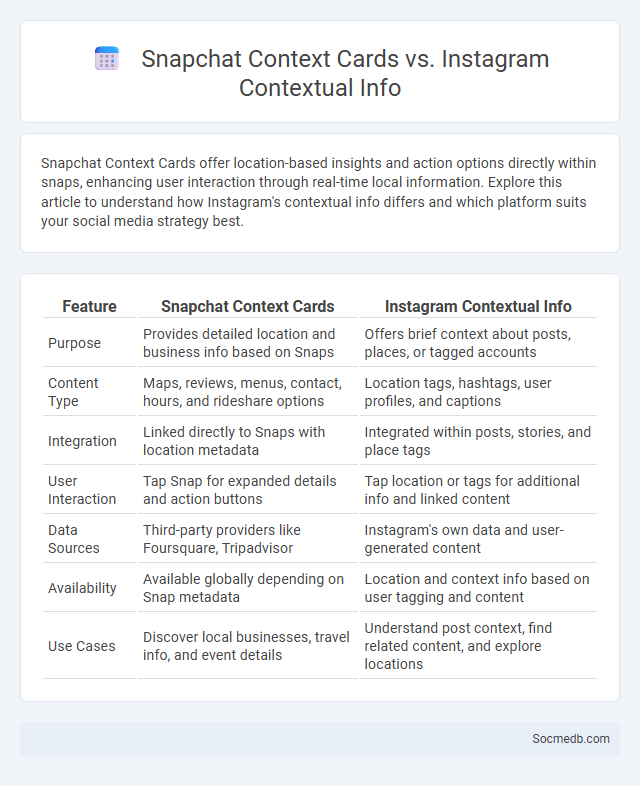
Photo illustration: Snapchat Context Cards vs Instagram Contextual Info
Snapchat Context Cards offer location-based insights and action options directly within snaps, enhancing user interaction through real-time local information. Explore this article to understand how Instagram's contextual info differs and which platform suits your social media strategy best.
Table of Comparison
| Feature | Snapchat Context Cards | Instagram Contextual Info |
|---|---|---|
| Purpose | Provides detailed location and business info based on Snaps | Offers brief context about posts, places, or tagged accounts |
| Content Type | Maps, reviews, menus, contact, hours, and rideshare options | Location tags, hashtags, user profiles, and captions |
| Integration | Linked directly to Snaps with location metadata | Integrated within posts, stories, and place tags |
| User Interaction | Tap Snap for expanded details and action buttons | Tap location or tags for additional info and linked content |
| Data Sources | Third-party providers like Foursquare, Tripadvisor | Instagram's own data and user-generated content |
| Availability | Available globally depending on Snap metadata | Location and context info based on user tagging and content |
| Use Cases | Discover local businesses, travel info, and event details | Understand post context, find related content, and explore locations |
Introduction to Contextual Features in Social Media
Contextual features in social media refer to the various elements such as location, time, user activity, and social interactions that shape the relevance and personalization of content. These features enable platforms to deliver targeted advertisements, improve user engagement, and enhance content discovery through algorithms analyzing your behavior and preferences. Understanding contextual data helps businesses optimize social media strategies to connect with audiences more effectively and boost overall campaign performance.
What Are Snapchat Context Cards?
Snapchat Context Cards provide detailed information about locations, businesses, and events shared within snaps, enhancing your social media experience by offering maps, reviews, contact info, and more. These cards utilize integrated services like TripAdvisor, Foursquare, and OpenTable to deliver real-time data directly in the app. Using Context Cards, you can easily plan outings or learn about local spots without leaving Snapchat.
Understanding Instagram Contextual Info
Instagram's contextual information includes location tags, hashtags, captions, and user interactions that shape content relevance and engagement. Understanding these elements allows you to tailor your posts for better visibility and connect with your target audience more effectively. Leveraging Instagram's algorithm insights helps maximize reach and optimize your social media strategy.
Overview of Generic Context Cards
Generic Context Cards on social media platforms provide users with concise, relevant information about a topic, person, or event to enhance understanding and reduce misinformation. These cards typically include brief summaries, verified data, links to authoritative sources, and contextual background tailored to the content being viewed. By delivering essential context directly within user feeds, Generic Context Cards improve content credibility and user engagement.
Key Differences: Snapchat vs Instagram Contextual Tools
Snapchat emphasizes real-time, ephemeral content with features like Snaps, Stories, and augmented reality lenses that encourage spontaneous sharing, while Instagram offers a permanent, visually curated feed featuring posts, Stories, Reels, and IGTV designed for long-term content and brand building. Snapchat's contextual tools prioritize personal communication through private chats and mutual friend interactions, whereas Instagram integrates advanced business tools such as shopping tags, insights, and influencer collaborations to enhance audience engagement. Your choice between Snapchat and Instagram should consider whether you value momentary, intimate interactions or polished, lasting visual storytelling with powerful marketing capabilities.
Use Cases for Context Cards on Each Platform
Context cards on social media platforms enhance user engagement by providing concise, relevant information directly within posts or profiles, improving decision-making and content interaction. On Instagram, context cards help showcase product details and event information, streamlining the user journey from discovery to purchase. Twitter leverages context cards to offer additional content like article summaries or poll results, enriching the conversation and increasing content visibility.
User Experience and Engagement Comparison
Social media platforms vary significantly in user experience and engagement levels, with Instagram excelling in visual content and seamless interaction, while Twitter offers real-time updates and concise communication. Your engagement increases when platforms provide intuitive interfaces, personalized feeds, and interactive features like stories, polls, and live videos. Analyzing metrics such as average session duration and user interaction rates highlights where your audience is most active and engaged.
Privacy and Data Considerations
Social media platforms collect vast amounts of personal information, making privacy protection crucial for Your digital safety. Carefully reviewing privacy settings and understanding data sharing policies help minimize unauthorized access to Your sensitive data. Staying informed about platform security updates and using strong, unique passwords can significantly reduce the risk of data breaches and identity theft.
Impact on Marketing and Local Businesses
Social media platforms have revolutionized marketing by enabling local businesses to reach targeted audiences with cost-effective, personalized campaigns that drive engagement and sales. By leveraging user-generated content and localized advertising tools, businesses enhance their online visibility, build community trust, and attract foot traffic within specific geographic areas. Effective social media strategies increase brand awareness and customer loyalty, directly contributing to revenue growth for small and medium-sized enterprises.
Future Trends in Contextual Information on Social Media
Future trends in contextual information on social media emphasize real-time sentiment analysis and personalized content delivery using AI-driven algorithms. Enhanced integration of location data, user behavior patterns, and multimedia content will enable platforms to offer hyper-targeted advertising and improved user engagement. Emerging technologies like augmented reality (AR) and natural language processing (NLP) will further revolutionize how contextual information is captured and utilized for social interactions.
 socmedb.com
socmedb.com